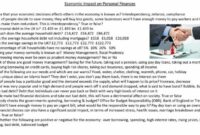The psychology of luxury lifestyle consumption explores the fascinating interplay between our minds and our desires for high-end goods and experiences. It delves into why we covet luxury items, how marketing influences our perceptions, and the broader societal implications of this spending. From the aspirational allure of a designer handbag to the exclusive appeal of a private jet, understanding the psychological drivers behind these purchases reveals a complex tapestry of self-image, social status, and emotional fulfillment.
This exploration goes beyond simply the price tag, examining the cultural significance attached to luxury brands and the ways in which they shape our identities. We’ll investigate the distinct motivations behind luxury purchases, considering both rational and emotional factors, and analyze how marketing strategies skillfully tap into our deepest desires. Ultimately, understanding the psychology of luxury consumption offers valuable insights into consumer behavior and the ever-evolving landscape of the luxury market.
Defining Luxury Consumption

Source: fourreasonslegal.com
Luxury consumption is far more complex than simply purchasing high-priced items. It’s a multifaceted experience encompassing social status, emotional fulfillment, and a sense of exclusivity, all interwoven with the inherent value and quality of the product or service. Price, while a significant factor, doesn’t solely define luxury; it’s the combination of price, craftsmanship, heritage, exclusivity, and the emotional connection it fosters with the consumer that truly distinguishes a luxury item.Luxury goods and services span diverse categories, reflecting varying consumer aspirations and lifestyles.
The perceived value, therefore, differs greatly depending on individual priorities and cultural contexts.
Examples of Luxury Goods and Services
Luxury items aren’t limited to tangible products. The experience itself can be a defining factor. Consider a bespoke tailored suit from a renowned Italian tailor, a stay at a five-star hotel with personalized butler service, a private jet charter to a remote island resort, or a limited-edition artwork by a celebrated artist. These examples demonstrate the breadth and depth of the luxury market, ranging from tangible goods to intangible experiences.
In the automotive sector, brands like Rolls-Royce and Bentley exemplify luxury through their craftsmanship, bespoke options, and exclusive clientele. Similarly, in the fashion industry, haute couture houses like Chanel and Dior represent the pinnacle of luxury design and craftsmanship. High-end watches from brands such as Patek Philippe and Rolex also occupy a significant space within the luxury market, valued for their heritage, precision, and exclusivity.
Finally, culinary experiences, such as Michelin-starred restaurants offering unique and exceptional dining experiences, can also be considered luxury services.
Aspirational, Accessible, and Exclusive Luxury
The luxury market is segmented into distinct tiers based on accessibility and target audience. Aspirational luxury refers to brands and products that consumers desire but may not be immediately attainable due to cost or limited availability. These brands often act as a powerful motivator, driving consumers towards financial goals and lifestyle changes. Examples include luxury car brands like BMW or Mercedes-Benz, or designer handbags from brands like Michael Kors or Coach.
Accessible luxury, on the other hand, represents a more attainable segment offering a taste of luxury at a more affordable price point. This segment often leverages mass production techniques while maintaining a level of quality and design that resonates with luxury aspirations. Brands like Kate Spade or Tory Burch often fall under this category. Finally, exclusive luxury encompasses the most coveted and unattainable items, characterized by extreme scarcity, high prices, and meticulous craftsmanship.
These are often bespoke items or limited-edition releases with waiting lists, and their exclusivity adds significantly to their desirability. Examples include haute couture garments, one-of-a-kind jewelry, or limited-production supercars.
Luxury Market Segmentation
The luxury market is further categorized into various segments, each with its own characteristics and target audience.
| Segment | Price Point | Target Audience | Marketing Strategy |
|---|---|---|---|
| Masstige | Mid-range to high | Aspirational consumers seeking accessible luxury | Focuses on brand awareness and accessibility |
| Prestige | High to very high | Affluent consumers seeking exclusive and high-quality products | Emphasizes heritage, craftsmanship, and exclusivity |
| Ultra-Luxury | Extremely high | High-net-worth individuals seeking bespoke and highly personalized experiences | Focuses on personalized service and unparalleled exclusivity |
| Heritage Luxury | Varies | Consumers valuing history, tradition, and craftsmanship | Highlights brand history, legacy, and timelessness |
Psychological Drivers of Luxury Purchases
The allure of luxury goods extends far beyond their material value. Understanding why people purchase luxury items requires delving into the complex interplay of psychological factors that drive these decisions. These purchases are often deeply intertwined with our sense of self, our social standing, and our fundamental psychological needs.
Self-Image and Identity in Luxury Consumption
Luxury purchases frequently serve as powerful tools in shaping and reinforcing self-image. Individuals may select items that align with their desired identity, projecting an image of success, sophistication, or exclusivity. For example, someone aiming for a powerful executive persona might invest in a high-end suit and watch, while an individual prioritizing artistic expression might choose unique, handcrafted jewelry.
The act of purchasing and owning these items becomes a form of self-expression, allowing individuals to communicate their values and aspirations to themselves and others. This is not simply about material possessions; it’s about the narrative these possessions create around the individual’s identity.
The Influence of Social Status and Social Comparison
Social status and the inherent drive for upward social mobility significantly influence luxury consumption. Individuals often purchase luxury goods to signal their social standing, either to maintain their current position or to aspire to a higher one. Social comparison plays a crucial role; individuals assess their own status relative to others, and luxury purchases can be a means of competing for or maintaining social prestige.
The visibility of luxury brands further enhances this effect, as the logos and branding act as readily identifiable status symbols. Consider the impact of owning a particular luxury car or wearing a designer handbag – these items instantly communicate a certain level of affluence and social standing.
Psychological Needs Met by Luxury Purchases
Luxury purchases frequently fulfill a range of fundamental psychological needs. The acquisition of luxury items can boost self-esteem and provide a sense of accomplishment, particularly when the purchase represents a significant achievement or reward. Furthermore, luxury goods can foster a sense of belonging, particularly within specific social groups or communities that value certain brands or styles. The feeling of exclusivity and membership that comes with owning certain luxury items can be highly motivating.
For instance, joining a private club with a specific dress code may be an example of satisfying both self-esteem and belonging needs through luxury consumption.
Emotional versus Rational Luxury Purchases
The motivations behind luxury purchases can be broadly categorized as emotional or rational. Emotional purchases are driven by feelings, desires, and impulses, often linked to immediate gratification and self-reward. These purchases may be less concerned with practical value and more focused on the emotional satisfaction derived from owning the item. Rational luxury purchases, on the other hand, are more deliberate and calculated.
They may involve careful consideration of value, quality, and long-term investment potential. However, even seemingly rational purchases often have an emotional component, such as the pride associated with owning a well-crafted, durable item. The line between emotional and rational motivations can be blurred, with many luxury purchases incorporating elements of both.
The Impact of Marketing and Branding on Luxury Perception
Luxury brands don’t just sell products; they sell an aspirational lifestyle. Their marketing strategies are meticulously crafted to cultivate a sense of exclusivity and desirability, tapping into deep-seated psychological needs and desires. This section explores how marketing and branding shape our perception of luxury goods.
Strategies for Cultivating Exclusivity
Luxury brands employ several key strategies to maintain an aura of exclusivity. Limited-edition releases, carefully controlled distribution channels (e.g., exclusive boutiques, online-only drops), and high price points all contribute to this perception of scarcity and desirability. The feeling of being part of a select group, able to afford and appreciate these items, is a powerful motivator. This is further amplified by personalized experiences, such as bespoke services and VIP events, which create a sense of belonging and special treatment.
Furthermore, restricting access through waiting lists or requiring appointments fosters a sense of privilege and heightened desire. The very act of obtaining the luxury item becomes a statement of achievement.
Storytelling and Heritage in Luxury Brand Building
Many luxury brands leverage their history and heritage to craft compelling narratives. These stories often involve craftsmanship, tradition, and family legacies, imbuing the products with a sense of authenticity and timelessness. Think of the meticulous hand-stitching emphasized by Hermès or the centuries-old family history of Gucci. This narrative approach goes beyond simply showcasing the product; it weaves a story that resonates emotionally with consumers, connecting the brand to a sense of legacy and quality that transcends mere material value.
The storytelling creates an emotional connection, making the purchase more than a transaction; it becomes an investment in a story and a heritage.
Examples of Effective Luxury Marketing Campaigns and Their Psychological Impact
Chanel’s No. 5 perfume, with its iconic imagery and association with timeless elegance and glamour, has been a masterclass in luxury marketing for decades. The campaign consistently taps into the desire for sophistication and self-assuredness. Similarly, the minimalist aesthetic and understated luxury of brands like Apple successfully appeal to the psychological need for simplicity and sophistication, while their product launches generate excitement and a sense of community among loyal followers.
The carefully curated imagery and messaging in these campaigns evoke specific emotions and aspirations, associating the product with a desired lifestyle.
A Hypothetical Luxury Brand Campaign: Addressing the Need for Self-Expression
Let’s imagine a new luxury watch brand, “Chronos,” targeting young, successful professionals who value individuality and self-expression. The campaign, titled “Define Your Time,” would feature a series of short films showcasing diverse individuals wearing the Chronos watch in their unique environments. Each film would highlight a specific personality and lifestyle, emphasizing the watch’s versatility and adaptability. The overall message would be that the Chronos watch is not just a timepiece, but a statement of personal identity and ambition, allowing the wearer to “define their own time” on their own terms.
This campaign would directly address the psychological need for self-expression and belonging, associating the watch with a sense of freedom and control over one’s life. The visual language would be modern and sophisticated, yet subtly rebellious, reflecting the target audience’s values. The campaign would utilize social media influencers to further amplify its message and reach a wider audience, fostering a sense of community among Chronos wearers.
Luxury Consumption and Consumer Behavior: The Psychology Of Luxury Lifestyle Consumption
Understanding luxury consumption requires examining the intricate interplay between psychological drivers, marketing strategies, and the unique behaviors of consumers within this specialized market. This section delves into the consumer journey, cultural influences, market segmentation, and the decision-making process associated with luxury purchases.
A Case Study: The Consumer Journey for a Luxury Watch
Let’s consider the purchase of a Rolex Submariner, a highly sought-after luxury watch. The consumer journey typically begins with aspiration, perhaps fueled by seeing the watch on a celebrity or in a magazine. This initial awareness evolves into research, where the potential buyer investigates the watch’s history, craftsmanship, and prestige. The next stage involves consideration, weighing the Rolex against other high-end watches.
This might involve visiting boutiques, comparing specifications online, and seeking advice from watch enthusiasts. The decision to purchase is often driven by a combination of factors – the watch’s perceived value, its status symbol, and the emotional connection it evokes. Finally, the post-purchase experience involves the pride of ownership, potential membership in an exclusive community of Rolex owners, and the ongoing care and maintenance of the timepiece.
This journey highlights the significant time and emotional investment involved in luxury purchases, extending far beyond a simple transactional exchange.
Cultural Factors Influencing Luxury Consumption Patterns
Culture profoundly shapes luxury consumption patterns. For example, in some Asian cultures, luxury goods are frequently given as gifts, signifying status and success within social circles. This contrasts with Western cultures where luxury purchases might be more self-rewarding, expressing individual achievement and personal taste. Similarly, the preference for specific luxury brands can vary widely across cultures. A brand highly valued in one region might hold less appeal in another, reflecting differing cultural aesthetics, values, and social norms.
These cultural nuances necessitate tailored marketing strategies for luxury brands seeking global success.
Luxury Consumer Segmentation
The luxury market is far from homogenous. Several distinct consumer segments exist, each with its unique characteristics:
- The Heritage Consumer: This segment values tradition, craftsmanship, and established brands with a long history. They are often less swayed by trends and prioritize quality and enduring value.
- The Aspirational Consumer: This group desires to attain a luxury lifestyle and views luxury purchases as a means of social climbing or self-improvement. They are often more sensitive to price and may be influenced by marketing campaigns that emphasize status and exclusivity.
- The Experiential Consumer: This segment prioritizes unique experiences and personalized services associated with luxury brands. They are less concerned with owning tangible goods and more interested in the memories and connections created through luxury interactions.
- The Hedonistic Consumer: This group focuses on immediate gratification and self-indulgence. They may be impulsive buyers, driven by emotional desires and the pleasure derived from luxury purchases.
Understanding these distinct segments allows luxury brands to develop targeted marketing and product offerings that resonate with specific consumer needs and desires.
The Luxury Purchase Decision-Making Process
The decision-making process for luxury purchases is often more complex and protracted than for everyday goods. Several key steps are typically involved:
- Need Recognition/Aspiration: The process begins with a perceived need or desire, often fueled by aspirational goals or social influence.
- Information Search: Extensive research is undertaken, involving various sources such as online reviews, expert opinions, and word-of-mouth recommendations.
- Evaluation of Alternatives: Potential buyers carefully compare different luxury options, considering factors like quality, brand reputation, and aesthetic appeal.
- Purchase Decision: The final decision is often influenced by emotional factors, brand loyalty, and the perceived value proposition.
- Post-Purchase Evaluation: The experience after the purchase is crucial. Positive experiences reinforce brand loyalty, while negative experiences can lead to dissatisfaction.
This meticulous process reflects the high stakes involved in luxury purchases, highlighting the importance of exceptional customer service and a strong brand reputation for luxury providers.
The Ethical Considerations of Luxury Consumption
The pursuit of luxury goods often clashes with ethical concerns regarding environmental sustainability and social responsibility. The production and consumption of luxury items, while often associated with prestige and exclusivity, frequently carry significant environmental and social costs that demand critical examination. This section explores these ethical dilemmas, highlighting both the challenges and potential solutions within the luxury industry.The Environmental Impact of Luxury Production and ConsumptionLuxury goods often require extensive resources and energy-intensive production processes.
From the sourcing of raw materials like precious metals and exotic skins to the manufacturing and transportation of finished products, significant environmental footprints are created. For example, the mining of diamonds often involves habitat destruction and the displacement of local communities. Similarly, the production of leather goods contributes to deforestation and greenhouse gas emissions. The fashion industry, a significant contributor to the luxury market, is known for its substantial water consumption and textile waste.
Moreover, the frequent purchase and disposal of luxury items contribute to a culture of consumerism that exacerbates environmental problems.
Ethical Dilemmas Faced by Luxury Brands and Consumers
Luxury brands face a complex ethical landscape. Balancing the demand for high-quality, exclusive products with the need for environmentally and socially responsible practices presents a significant challenge. Consumers, too, face ethical dilemmas. The desire for status and exclusivity often outweighs concerns about the ethical sourcing and production of the goods they purchase. This creates a tension between personal gratification and responsible consumption.
Brands may engage in “greenwashing,” making misleading claims about their sustainability efforts to attract environmentally conscious consumers without significantly altering their practices. Consumers may also experience “ethical fatigue,” feeling overwhelmed by the sheer number of ethical considerations and choosing to ignore them.
Sustainable and Ethical Luxury Practices
Several luxury brands are adopting sustainable and ethical practices. These include using recycled or sustainably sourced materials, reducing water and energy consumption in production, implementing fair labor practices, and investing in carbon offsetting programs. For instance, some brands utilize recycled gold and platinum in their jewelry, while others source leather from tanneries committed to environmentally responsible practices. Transparency in supply chains is also becoming increasingly important, with brands disclosing information about their sourcing and manufacturing processes to build consumer trust.
Certifications like Fairtrade and GOTS (Global Organic Textile Standard) help consumers identify brands committed to ethical practices.
A Hypothetical Ethical Luxury Brand: “Evergreen”
Imagine “Evergreen,” a hypothetical luxury brand focused on sustainable and ethical practices. Evergreen’s clothing line would utilize organic, locally sourced cotton and employ fair-trade manufacturing in a facility powered by renewable energy. Their packaging would be made from recycled materials, and they would prioritize minimal waste production. Evergreen’s marketing strategy would emphasize transparency and authenticity, showcasing their sustainable production processes and the positive social impact of their operations.
Their advertising campaigns would focus on timeless elegance and enduring quality rather than fleeting trends, encouraging customers to invest in fewer, higher-quality items. This approach would promote a shift from fast fashion to a more conscious and sustainable consumption model. Evergreen would actively engage with local communities, supporting artisans and contributing to environmental conservation efforts. The brand’s pricing would reflect the higher costs associated with sustainable production, targeting consumers who value both luxury and ethical responsibility.
Future Trends in Luxury Consumption
The luxury market is dynamic, constantly evolving in response to technological advancements and shifting consumer preferences. Predicting its future requires considering not only technological disruptions but also the enduring human desire for exclusivity, craftsmanship, and experiences. We’ll explore key trends shaping the future of luxury consumption, focusing on technology’s impact, the rise of the sharing economy, and the evolving role of digital platforms.
Technological Advancements and Changing Consumer Values
Technological advancements are profoundly reshaping luxury consumption. Personalization is key; AI-powered platforms are enabling brands to offer highly customized products and services, catering to individual preferences and needs. For example, bespoke clothing services are incorporating 3D body scanning technology to ensure perfect fits, while luxury car manufacturers are utilizing augmented reality to allow customers to virtually configure their vehicles.
Simultaneously, a growing emphasis on sustainability and ethical sourcing is influencing consumer choices. Consumers are increasingly demanding transparency and accountability from luxury brands, favoring those committed to eco-friendly practices and fair labor standards. This shift is evident in the rising popularity of brands utilizing recycled materials or partnering with ethical artisans.
The Impact of the Sharing Economy on the Luxury Market, The psychology of luxury lifestyle consumption
The sharing economy, while initially associated with budget-friendly options, is making inroads into the luxury market. Luxury goods rental platforms, such as those offering high-end handbags or designer clothing for short-term use, are gaining traction. This allows consumers to experience luxury without the significant financial commitment of ownership. This trend is particularly appealing to younger generations who prioritize experiences over material possessions.
The impact on the luxury market is a shift from ownership to access, creating new revenue streams for brands and altering the traditional model of luxury consumption. Consider the success of luxury car subscription services, providing access to high-end vehicles without the long-term commitment of purchase.
The Evolving Role of Digital Platforms in Luxury Marketing and Sales
Digital platforms are no longer just marketing channels; they are integral to the luxury shopping experience. Luxury brands are investing heavily in creating immersive online experiences, leveraging high-quality visuals, interactive content, and personalized recommendations to engage customers. Livestream shopping events, virtual showrooms, and personalized digital styling consultations are becoming increasingly common. Social media platforms like Instagram and WeChat are crucial for building brand awareness and fostering community among luxury consumers.
The success of luxury brands on these platforms hinges on creating engaging content that resonates with their target audience and fostering a sense of exclusivity and community.
A Visual Representation of the Future of Luxury Consumption
Imagine a sleek, minimalist showroom, largely virtual but with physical elements. Customers use augmented reality headsets to explore and customize luxury products, receiving personalized recommendations based on their digital profiles. A large screen displays sustainable sourcing information and ethical production details. Nearby, a curated selection of luxury items is available for rental, highlighting a shift towards access over ownership.
The overall atmosphere is sophisticated yet relaxed, emphasizing personalized experiences and transparency. The space blends physical and digital elements seamlessly, reflecting a future where technology enhances, rather than replaces, the human touch inherent in luxury consumption.
Final Thoughts
In conclusion, the psychology of luxury lifestyle consumption is a multifaceted field revealing much about human behavior and societal values. The pursuit of luxury is not solely about material possessions; it’s a complex interplay of self-expression, social signaling, and the fulfillment of deep-seated psychological needs. By understanding the underlying motivations and the ethical considerations involved, we can gain a more nuanced perspective on this significant aspect of modern consumer culture and its impact on individuals and the world around us.
The future of luxury, shaped by technological advancements and evolving consumer values, promises to be both dynamic and intriguing.
Questions Often Asked
What is the difference between “aspirational” and “accessible” luxury?
Aspirational luxury refers to brands and items that are highly desirable but unattainable for most consumers. Accessible luxury, on the other hand, represents high-quality goods and services that are within reach of a broader consumer base.
How does the sharing economy impact luxury consumption?
The sharing economy, through platforms offering rentals or access to luxury goods, challenges traditional ownership models. It makes luxury experiences more accessible but could potentially diminish the exclusivity associated with luxury brands.
Are there ethical concerns related to luxury brand sustainability?
Yes, ethical concerns include the environmental impact of production (e.g., resource depletion, pollution), labor practices (e.g., fair wages, safe working conditions), and the social responsibility of brands regarding their supply chains.
How can I tell if a luxury item is authentic?
Authenticity verification often involves checking for hallmarks, serial numbers, and comparing the item to known characteristics of the brand. Purchasing from authorized retailers is crucial. Independent authentication services also exist.





